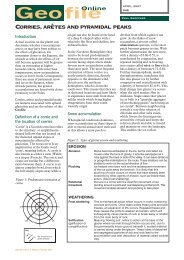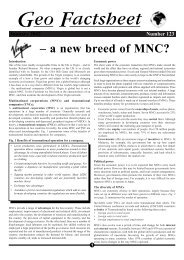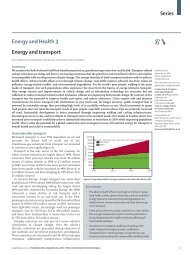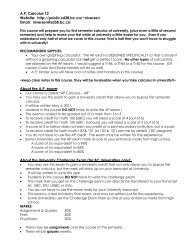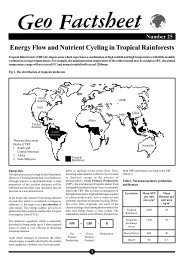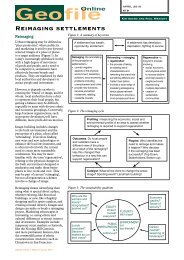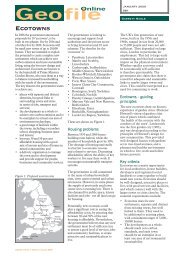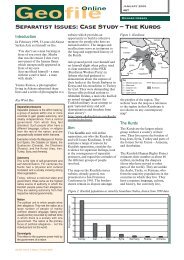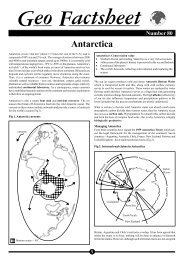Geo file - School-Portal.co.uk
Geo file - School-Portal.co.uk
Geo file - School-Portal.co.uk
You also want an ePaper? Increase the reach of your titles
YUMPU automatically turns print PDFs into web optimized ePapers that Google loves.
<strong>Geo</strong><strong>file</strong><br />
Online<br />
RIVER BASIN MANAGEMENT:<br />
THE NILE AND MISSISSIPPI<br />
Introduction<br />
Water is a precious resource, but it<br />
can be taken for granted in nations<br />
like Britain where there is normally<br />
an abundant supply. It is perhaps<br />
difficult for us to appreciate just how<br />
different the situation in some<br />
<strong>co</strong>untries can be. For instance,<br />
Boutros Boutros Ghali (former<br />
foreign minister of Egypt and UN<br />
Secretary-General), speaking about<br />
north east Africa, has said: “The next<br />
war in our region will be over the<br />
waters of the Nile, not politics.”<br />
We will see in this <strong>Geo</strong><strong>file</strong> how some<br />
rivers can have many <strong>co</strong>mpeting<br />
demands for their water, sometimes<br />
from different nations. Rivers bring<br />
many benefits, but also problems,<br />
notably flooding, as experienced in<br />
Britain in the autumn of 2000. It is<br />
essential that rivers are managed to<br />
meet these <strong>co</strong>mpeting demands and<br />
to reduce <strong>co</strong>nflict; this is clearly<br />
illustrated by two of the world’s<br />
largest rivers, the Nile and the<br />
Mississippi.<br />
The Nile<br />
Background<br />
The Nile is 6825 km in length from<br />
its source in Lake Victoria in<br />
Uganda and Tanzania to its mouth at<br />
the Mediterranean Sea. The drainage<br />
basin is huge: at 2.6 m. km 2 it <strong>co</strong>vers<br />
about one-tenth of Africa and<br />
includes land from 10 different<br />
<strong>co</strong>untries, although most of the basin<br />
is in Egypt. The regime of the Nile is<br />
influenced by the seasonal patterns<br />
of its three main tributaries, the<br />
White Nile, Blue Nile and the Atbara<br />
(Figure 1).<br />
Figure 1: The Nile basin<br />
JANUARY 2002<br />
416<br />
Paul Warburton<br />
Causes of flooding<br />
For thousand of years the lower<br />
reaches of the Nile flooded annually<br />
during August and September. This<br />
resulted from heavy rainfall in the<br />
Ethiopian Highlands in the Blue<br />
Nile’s upper <strong>co</strong>urse in July and June.<br />
Each year as the river flooded it<br />
deposited fertile silt on the<br />
floodplain, vital to farmers. This was<br />
particularly important in the Nile<br />
delta, which has some of Africa’s<br />
most productive farmland. In<br />
addition, the Nile is important for<br />
transport and as a source of water for<br />
domestic and industrial uses. The<br />
flooding however has occasionally<br />
been very severe. In September 1998<br />
the rainfall was exceptional; the Nile<br />
rose by 16m and burst its banks,<br />
causing the worst flooding in Sudan<br />
for 50 years. Many mud buildings<br />
<strong>co</strong>llapsed and thousands of people<br />
were left without fresh water, food or<br />
shelter.<br />
Management of the basin and<br />
responses to flooding<br />
In 1960 work began on the<br />
<strong>co</strong>nstruction of the Aswan High Dam<br />
(Figure 1). This was <strong>co</strong>mpleted in<br />
1968, at a <strong>co</strong>st of more than US$1 bn.<br />
Lake Nasser, the reservoir created by<br />
the dam, is one of the largest in the<br />
world, and it drowned many villages<br />
along the <strong>co</strong>urse of the river. The dam<br />
is a good example of a hard<br />
engineering approach to river<br />
<strong>Geo</strong><strong>file</strong> Online © Nelson Thornes 2002
January 2002 no.416 River Basin Management: The Nile and Mississippi<br />
management (Figure 2). The dam<br />
<strong>co</strong>ntrols the flow of the Nile and has<br />
prevented further problems<br />
downstream in Egypt related to<br />
flooding; other benefits include<br />
improved navigation on the Nile and<br />
HEP from the dam. There are<br />
however a number of disadvantages.<br />
The fertile silt formerly deposited by<br />
the Nile now accumulates behind the<br />
dam. Soil quality downstream is<br />
deteriorating because of the<br />
accumulation of salt from chemical<br />
fertilisers that have been used instead<br />
of the silt. The river also leaves<br />
behind mineral salts; without the<br />
annual floods to wash these away,<br />
salinisation has be<strong>co</strong>me a serious<br />
problem on the delta. Certain<br />
diseases like malaria and sleeping<br />
sickness have also increased, as a<br />
result of the still waters in the Lake<br />
and irrigation channels.<br />
Water from the Nile is used for<br />
irrigation, and this use is expanding.<br />
By 2003 a new scheme along the<br />
<strong>co</strong>astal edge of the Sinai Peninsula<br />
should be <strong>co</strong>mpleted. The “Northern<br />
Sinai Development Project” will turn<br />
250,000 hectares of desert into<br />
productive farmland. New towns will<br />
be built there and it is hoped that<br />
this will eventually make it possible<br />
to resettle 1.5 million people from<br />
the overcrowded Nile valley,<br />
relieving some of the pressure on<br />
Cairo (population 16 million, 2000).<br />
The increased food production will<br />
redce Egypt’s need to import food.<br />
Water for the project will be<br />
tunnelled from the Nile and<br />
transported along the 180 km long<br />
Salam Canal which includes tunnels<br />
under the Suez canal.<br />
Figure 2: Hard and soft engineering approaches to river basin management<br />
Hard engineering:<br />
Soft engineering:<br />
dam near the source of the Blue Nile;<br />
this <strong>co</strong>uld divert 39% of the river’s<br />
water. Egypt has already threatened<br />
to attack Ethiopia, which it claims is<br />
taking too much water from the Nile.<br />
In 1959 Egypt and Ethiopia signed a<br />
treaty on using the Nile, but in light<br />
of the rising tensions a new<br />
international agreement was needed.<br />
In February 1999 all 10 Nile Basin<br />
<strong>co</strong>untries agreed to <strong>co</strong>-operate under<br />
the “Nile Basin Initiative” so that<br />
use of the water is fairer in the<br />
future, bringing benefits to all.<br />
The Mississippi<br />
Background<br />
The management of the Mississippi<br />
<strong>co</strong>ncerns the battle against nature,<br />
rather than tensions between<br />
<strong>co</strong>untries. The Mississippi is about<br />
3,800 km long from its source in Lake<br />
Itasca to the Gulf of Mexi<strong>co</strong> (Figure<br />
3). The river drains a huge area of the<br />
United States, about 3,256,000 km2<br />
between the Rockies and the<br />
Appalachians. There are about 250<br />
Figure 3: The Mississippi Basin<br />
The use of structures such as dams, floodgates,<br />
barriers and levees to <strong>co</strong>ntrol the natural behaviour of<br />
rivers, particularly erosion and flooding.<br />
Approaches to the problem which are natural and<br />
which seek to minimise environmental impact by<br />
working with river processes and other natural<br />
aspects of the environment, like vegetation, to <strong>co</strong>ntrol<br />
erosion and flooding.<br />
tributaries, the main ones being the<br />
Ohio, Kansas, Red and Missouri<br />
rivers.<br />
Causes of flooding<br />
When settlers first came to the<br />
Mississippi valley they benefited<br />
from the rich soil and the abundant<br />
wildlife. The flood plain soon<br />
became densely settled and towns<br />
and cities developed. However, the<br />
Mississippi is prone to flooding. The<br />
upper Mississippi and its tributaries<br />
reach maximum flow between<br />
March and June; floods develop<br />
when melting snows are followed by<br />
early summer rains. Serious floods<br />
occurred in 1927 and 1974, and most<br />
recently in 1993 when discharge was<br />
exceptionally high (Figure 4). The<br />
1993 floods killed 50 people, 62,000<br />
families were evacuated, 55 towns<br />
were wrecked and $12 bn worth of<br />
property was destroyed in this part<br />
of the USA.<br />
As people have settled on the flood<br />
plain, wetlands have progressively<br />
The international nature of the Nile<br />
basin means that extraction of water<br />
in one part of the basin affects use in<br />
another. Egypt and Sudan ac<strong>co</strong>unt<br />
for about 60% of the water taken<br />
from the Nile. In the future, the<br />
Sudd swamps in southern Sudan<br />
<strong>co</strong>uld be drained and the water<br />
moved north by a canal. This would<br />
represent an important additional<br />
water resource for Egypt and Sudan,<br />
but there would be <strong>co</strong>nsiderable<br />
environmental impact.<br />
Problems of poverty, civil war and<br />
debt have made it difficult for other<br />
Nile <strong>co</strong>untries to use much water in<br />
the past. Gradually, however, more of<br />
these <strong>co</strong>untries are industrialising<br />
and expanding agriculture, the<br />
demand for HEP is likely to increase<br />
and the <strong>co</strong>mpetition for the water is<br />
growing. Ethiopia plans to build a<br />
<strong>Geo</strong><strong>file</strong> Online © Nelson Thornes 2002
January 2002 no.416 River Basin Management: The Nile and Mississippi<br />
Figure 4: Mississippi River discharge and the 1993 floods<br />
In 1993, as had occurred in 1927 and<br />
1974, inhabitants along the<br />
Mississippi were shocked when the<br />
protective network of levees was overtopped<br />
or breached and the waters<br />
unleashed on to the towns and<br />
farmland along its edge. Such events<br />
have prompted researchers since 1974<br />
to ask to what extent levees and other<br />
human modifications to the river<br />
system have actually worsened the<br />
threat to humans and property when<br />
the inevitable large floods occur.<br />
been drained and areas of forest that<br />
once absorbed excess rainwater have<br />
been cleared, to ac<strong>co</strong>mmodate<br />
settlements. Rivers have been<br />
channelled and land uses developed<br />
which also increased the speed and<br />
force of water flows across the land.<br />
Many believe that these human<br />
activities, by diminishing the ability of<br />
the land to absorb rainfall, have<br />
gradually <strong>co</strong>ntributed to more<br />
frequent and severe floods.<br />
Recent floods have also been more<br />
<strong>co</strong>stly, due to additional urban<br />
<strong>co</strong>mmunities being built on the<br />
floodplain, often close to the rivers. In<br />
the past, only occasional farmhouses<br />
tended to be destroyed by floods, but<br />
now they affect valuable transport<br />
infrastructure and more valuable<br />
property.<br />
The exceptional rainfall <strong>co</strong>ntributing<br />
to the floods of 1993 resulted from a<br />
high-pressure system in the south east<br />
forcing air from the Gulf of Mexi<strong>co</strong> to<br />
move north which met <strong>co</strong>ol north<br />
westerly air. The warm air rose over<br />
the <strong>co</strong>ld, leading to heavy frontal<br />
rainfall.<br />
Management of the basin and<br />
responses to flooding<br />
The approach to basin management of<br />
the Mississippi has involved hard<br />
engineering. The two most <strong>co</strong>mmonly<br />
used methods of flood <strong>co</strong>ntrol along<br />
the Mississippi and its tributaries are<br />
reservoirs and levees. Within urban<br />
areas there are additional measures,<br />
including <strong>co</strong>ncrete walls, flood-gates<br />
to protect particular areas, drainage<br />
channels and pumping stations.<br />
Dredging is also carried out,<br />
particularly after severe floods, to<br />
<strong>Geo</strong><strong>file</strong> Online © Nelson Thornes 2002<br />
maintain navigability and to reduce<br />
river levels.<br />
Flood <strong>co</strong>ntrol reservoirs are built well<br />
upstream of the main waterway, on<br />
the tributaries. The Upper Mississippi<br />
has 20 major flood <strong>co</strong>ntrol reservoirs,<br />
all <strong>co</strong>ntrolled by the US Army Corps<br />
of Engineers. On a tributary that<br />
floods occasionally, floodwater is<br />
released from the reservoir after a<br />
flood, to prepare for any further influx<br />
of water during the same season.<br />
Levees are low ridges or earthen<br />
embankments of soil, sand or clay,<br />
built along the edges of a river (Figure<br />
5). They can occur naturally, but most<br />
of those in the Mississippi basin have<br />
been enlarged artificially. Man-made<br />
levees usually <strong>co</strong>nsist of an<br />
impermeable <strong>co</strong>ncrete wall<br />
surrounded by earthen material with<br />
grass (but not trees or shrubs) to<br />
reduce erosional damage.<br />
Figure 5: Levees<br />
It has been suggested that levees and<br />
other channelled structures put in<br />
place over the last century or so have<br />
systematically <strong>co</strong>nfined the flow of<br />
flood waters and forced flood stages to<br />
grow higher and higher for the same<br />
discharge. However, other researchers<br />
have refuted these ideas. The issue lies<br />
at the heart of a political movement to<br />
abandon portions of the Mississippi<br />
floodplain, remove the levees and<br />
reduce the hazard posed not only there<br />
but along the river system.<br />
Following the 1993 floods, the Army<br />
Corps of Engineers suggested that<br />
levee removal would not have a<br />
significant impact on lowering flood<br />
stages. Raising levees would not be<br />
very <strong>co</strong>st effective and <strong>co</strong>uld have<br />
adverse environmental effects. Flood<br />
reservoirs were stated as being<br />
particularly effective <strong>co</strong>mbined with<br />
levees. If the levees were to be<br />
removed, it has been estimated that<br />
there would be a reduction in water<br />
level but that the river would be about<br />
10 miles wide and everything around<br />
the river would be ruined.<br />
The <strong>co</strong>nstruction of levees and dams,<br />
and the funding of flood insurance<br />
and federal relief to flood victims have<br />
in some ways en<strong>co</strong>uraged
January 2002 no.416 River Basin Management: The Nile and Mississippi<br />
development in flood-prone areas.<br />
This in turn increases the <strong>co</strong>st of<br />
damage in subsequent floods. Today,<br />
many <strong>co</strong>mmunities participate in the<br />
Federal Emergency Management<br />
Agency’s (FEMA) Flood Insurance<br />
Program. Communities agree to<br />
prevent unwise development in floodprone<br />
areas; only existing developed<br />
areas have access to flood insurance. If<br />
flood damage exceeds 50% of the preflood<br />
value of their homes, they are<br />
not allowed to rebuild on the same<br />
site. Local towns, cities, <strong>co</strong>mmunities<br />
and <strong>co</strong>unties have the authority to<br />
regulate development and it is their<br />
responsibility to enforce these policies.<br />
LANDSAT (satellite) imagery has<br />
been used to assess the extent of<br />
damage from floods. This can help to<br />
establish areas that are particularly at<br />
risk from flooding and help future<br />
planning.<br />
Conclusions<br />
The problems and issues we have<br />
examined in this <strong>Geo</strong><strong>file</strong> have arisen<br />
because people have chosen to live<br />
beside major rivers. In addition,<br />
people have modified the natural<br />
channels, the flood plains and also<br />
engaged in activities that have<br />
impacted on the tributaries feeding<br />
into these major rivers. To a degree,<br />
flooding and the behaviour of these<br />
rivers has been <strong>co</strong>ntrolled, however<br />
people have often been lulled into a<br />
false sense of security. Particularly in<br />
the USA, where the technology and<br />
support systems are more<br />
sophisticated, there has been a feeling<br />
that it is possible to engineer <strong>co</strong>mplete<br />
protection from the <strong>co</strong>nsequences of<br />
flooding. However, flood <strong>co</strong>ntrols<br />
which <strong>co</strong>nfine river water usually just<br />
displace flooding; more water is sent<br />
faster to <strong>co</strong>mmunities downstream.<br />
And as we have seen, the protection<br />
schemes sometimes fail, with<br />
devastating <strong>co</strong>nsequences. Trying to<br />
prevent rivers from flooding is a battle<br />
against Mother Nature, and inevitably<br />
sometimes nature will win.<br />
References<br />
Nile<br />
Bishop, V. and Prosser, R. (1995)<br />
Water resources: Process and<br />
Management, Collins Educational Ch.<br />
4. (including useful activities for<br />
students).<br />
Mississippi<br />
There are a number of useful web sites<br />
dealing with flooding (enter<br />
“Mississippi+Flooding”):<br />
Figure 6: Flood levels on the Mississippi at Cape Girardeau, 1844—1996<br />
Date Inches Date Inches Date Inches<br />
above above above<br />
seasonal seasonal seasonal<br />
mean mean mean<br />
1844 June 42.53 1939 April 22 36.1 1972 April 25-26 32.0<br />
1857 June 37.2 1941 Nov 9-10 32.1 1973 May 1 45.6<br />
1858 37.16 1942 July 2 36.8 1974 May 27 36.9<br />
1892 May 22 36.0 1943 May 27 42.3 1975 April 30 36.3<br />
1903 June 14 36.5 1944 May 3 40.7 1978 March 29 38.4<br />
1904 May 1 34.1 1945 April 4 38.7 1979 April 17 44.4<br />
1908 June 21-23 36.0 1946 Jan 15 33.65 1981 May 23 35.7<br />
1909 July 18 35.0 1947 July 5-6 41.88 1982 Dec 10 43.5<br />
1912 April 4 34.95 1948 March 29 37.8 1983 May 6 44.9<br />
1915 Aug 24 34.3 1950 May 15 32.1 1984 April 27 38.93<br />
1916 Feb 3 36.4 1951 July 24 41.8 1985 March 1 41.11<br />
1917 June 16 34.2 1952 May 2-3 38.3 1986 Oct 11 42.06<br />
1920 April 1 32.2 1958 July 26 33.9 1990 May 21 39.63<br />
1922 April 22 38.0 1960 April 12 38.4 1992 Nov 27 33.7<br />
1926 Oct 10 32.9 1961 May 13 39.5 1993 Aug 8 47.9<br />
1927 April 20 39.95 1962 March 27 36.2 1994 April 17 41.89<br />
1928 June 24 32.8 1965 April 19 34.5 1995 My 24 46.67<br />
1929 May 22 37.4 1967 July 2 34.2 1996 May 17 40.60<br />
1933 May 19 34.4 1969 July 17 39.2<br />
1935 June 11 36.4 1970 May 5 35.7<br />
Source: US Army Corps of Engineers<br />
http:/www.agu.org/scisoc/walker:html<br />
http:/www.jracademy.<strong>co</strong>m/~mlechner<br />
/archive1999/report.html<br />
Focus<br />
Pictures of the 1993 Mississippi floods<br />
http://svs.gstc.nasa.gov/imagewall/Lan<br />
dS.<br />
Questions<br />
1. List the factors responsible for flooding on the Nile and<br />
Mississippi. Separate physical from human influences.<br />
2. Identify reasons why demand for water is growing in the Nile basin.<br />
3 (a) Discuss the possible <strong>co</strong>nsequences for Egypt if water shortages arise<br />
as a result of other <strong>co</strong>untries extracting more water from the Nile.<br />
(b) Can you think of any solutions to the problem.<br />
4. Plot the data in Figure 6 on a line graph. Comment on the level for<br />
1993 relative to the other levels on your <strong>co</strong>mpleted graph.<br />
5 (a) What are the gains and losses from dams for people living upstream<br />
and downstream<br />
(b) Try to research the <strong>co</strong>ntinuing maintenance required by dams.<br />
6. Use the internet to research the e<strong>co</strong>nomic <strong>co</strong>nsequences of the 1993<br />
Mississippi floods. Consider how different the <strong>co</strong>nsequences would be in<br />
an LEDC.<br />
7. Do you think levees should be built along the Mississippi and its<br />
tributaries, to prevent flooding<br />
8. To what extent should development be allowed to take place on land<br />
that is at risk from flooding<br />
ESSAY<br />
With reference to specific examples:<br />
(a) Outline the physical and human factors which can lead to flooding.<br />
(b) Evaluate management strategies used to regulate river flow and<br />
<strong>co</strong>ntrol flooding.<br />
<strong>Geo</strong><strong>file</strong> Online © Nelson Thornes 2002



